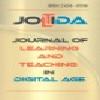Students’ Opinions on the Usage of Mobile Augmented Reality Application in Health Education
Students’ Opinions on the Usage of Mobile Augmented Reality Application in Health Education
___
- Bacca, J., Baldiris, S., Fabregat, R. & Graf, S. (2015). Mobile augmented reality in vocational education and training. Procedia Computer Science, 75, 49-58.
- Buchner, J. & Zumbach, J. (2018). Promoting Intrinsic Motivation with a Mobile Augmented Reality Learning Environment. International Association for Development of the Information Society. 14th International Conference Mobile Learning. p.55-61.
- Chen, P., Liu, X. & Huang, R. (2017). A review of using Augmented Reality in Education from 2011 to 2016. Innovations In Smart Learning, 13-18.
- Daud, K. , Hidayat, I., Rini, D. & Novica, D. (2020). The development of interactive hologram augmented reality card for Wonosari agro-tourism. Advances in Social Science, Education and Humanities Research, 2nd International Conference on Arts and Design Education (ICADE 2019), p.66-71.
- Eroğlu, M., Kaya, V. & Özbek, R. (2017). Can Mobile Learning Be an Opportunity for Undergraduate Teacher Education? European Journal of Social Science Education and Research, 4(6), 340-349.
- Fabian, K. & Topping, K. (2019). Putting “mobile” into mathematics: Results of a randomized controlled trial. Contemporary Educational Psychology, 59, 101783, 1-12 https://doi.org/10.1016/j.cedpsych.2019.101783
- Fadhil, M. and Sumardi, K. (2019, November). Survey of use mobile augmented reality for teaching materials. Annual Conference of Science and Technology, Journal of Physics: Conference Series, 1375(1), IOP Publishing. 1-4, doi:10.1088/1742-6596/1375/1/012085
- Guze, P. (2015). Using technology to meet the challenges of medical education. Transactions of the American clinical and climatological association, 126, 260. Licata, M., Bonsignore, A., Boano, R., Monza, F., Fulcheri, E., & Ciliberti, R. (2020). Study, conservation and exhibition of human remains: the need of a bioethical perspective. Acta bio-medica : Atenei Parmensis, 91(4),1-10, e2020110. https://doi.org/10.23750/abm.v91i4.9674
- Lochner, L., Wieser, H., Waldboth, S., & Mischo-Kelling, M. (2016). Combining traditional anatomy lectures with e-learning activities: how do students perceive their learning experience?. International journal of medical education, 7, 69–74. https://doi.org/10.5116/ijme.56b5.0369
- Marques, M. and Pombo, L. (2021, March). Teachers’experiences and perceptions regarding mobile augmented reality games: a case study of teacher training. In Proceedings of INTED2021 Conference Vol. 8, p. 8938-8947, ISBN: 978-84-09-27666-0
- Ozdamli, F. & Karagozlu, D. (2018). Preschool teachers’ opinions on the use of augmented reality application in preschool science education. Croatian Journal of Education: Hrvatski časopis za odgoj i obrazovanje, 20(1), 43-74.
- Parekh, P., & Shah, M. (2020). Systematic review and meta-analysis of augmented reality in medicine, retail, and games. Visual Computing For Industry, Biomedicine, And Art, 3(1), 1-20.
- Patil, S., Prabhu, C., Neogi, O., Joshi, A. & Katre, N. (2016, August). E-learning system using Augmented Reality. In 2016 International Conference on Computing Communication Control and automation (ICCUBEA) (pp. 1-5). IEEE.
- Saidin, N., Halim, N. & Yahaya, N. (2015). A review of research on augmented reality in education: Advantages and applications. International Education Studies, 8(13), 1-8.
- Vasilevski, N. & Birt, J. (2020). Analysing construction student experiences of mobile mixed reality enhanced learning in virtual and augmented reality environments. Research in Learning Technology, 28, 1-13.
- Weking, A. & Santoso, A. (2020). A Development of Augmented Reality Mobile Application to Promote the Traditional Indonesian Food. International Journal of Interactive Mobile Technologies, 14(9), 248-257.
- Zhu, E., Lilienthal, A., Shluzas, L. A., Masiello, I. & Zary, N. (2015). Design of mobile augmented reality in health care education: a theory-driven framework. JMIR Medical Education, 1(2), e4443.
- Yang, S., Mei, B. & Yue, X. (2018). Mobile augmented reality assisted chemical education: insights from elements 4D. American Chemical Society and Division of Chemical Education, 95, 1060−1062. DOI: 10.1021/acs.jchemed.8b00017
- Yayın Aralığı: 2
- Başlangıç: 2016
- Yayıncı: Mehmet Akif Ocak
Mehmet Fatih PEKYÜREK, Hatice YILDIZ DURAK, Mustafa SARITEPECİ, Yıldız ÖZAYDIN AYDOĞDU, Eda AKDOĞDU YILDIZ
Examination of Digital Game Addiction Levels of Adolescent Mainstreaming Students
Tuğba SİVRİKAYA, Müzeyyen ELDENİZ ÇETİN
Canan ÖZÇELİK AKAY, Ozlem CAKİR
Examining The Prediction of Digital Game Addiction Awareness on Digital Educational Game Usage
Burcu KARABULUT COŞKUN, Arif AKÇAY
Development and Validation of the Teachers’ Digital Competence Scale (TDiCoS)
Duygu YILMAZ ERGÜL, Mehmet Fatih TAŞAR
